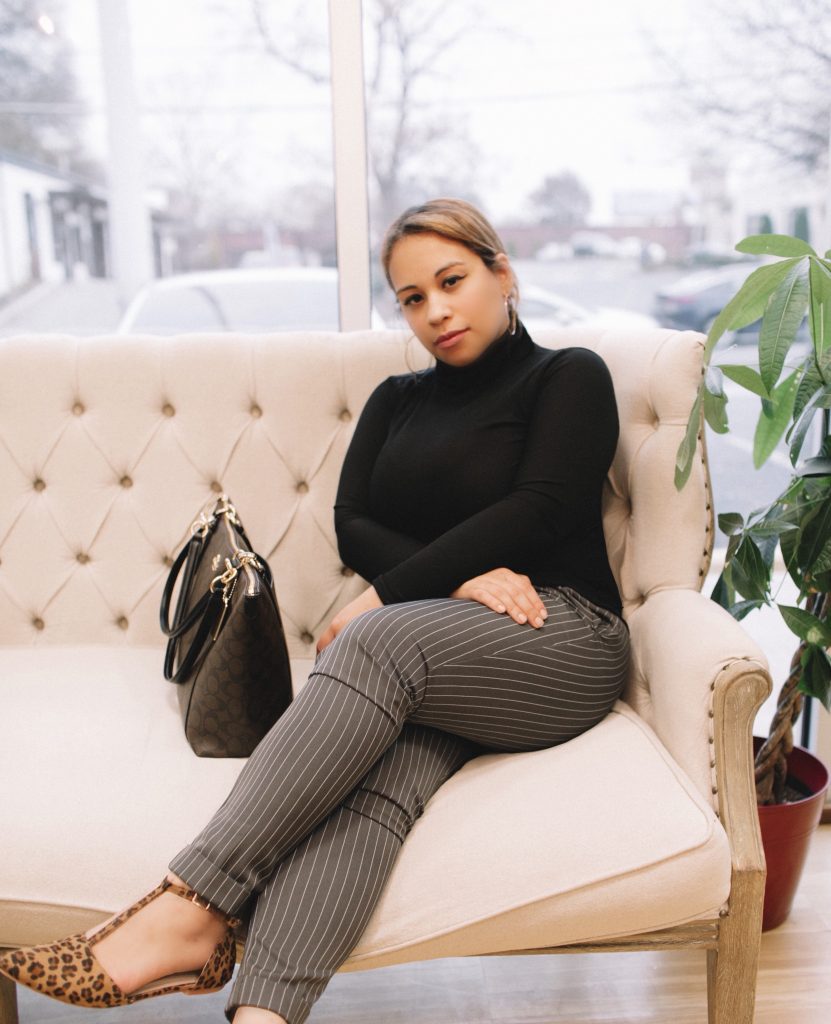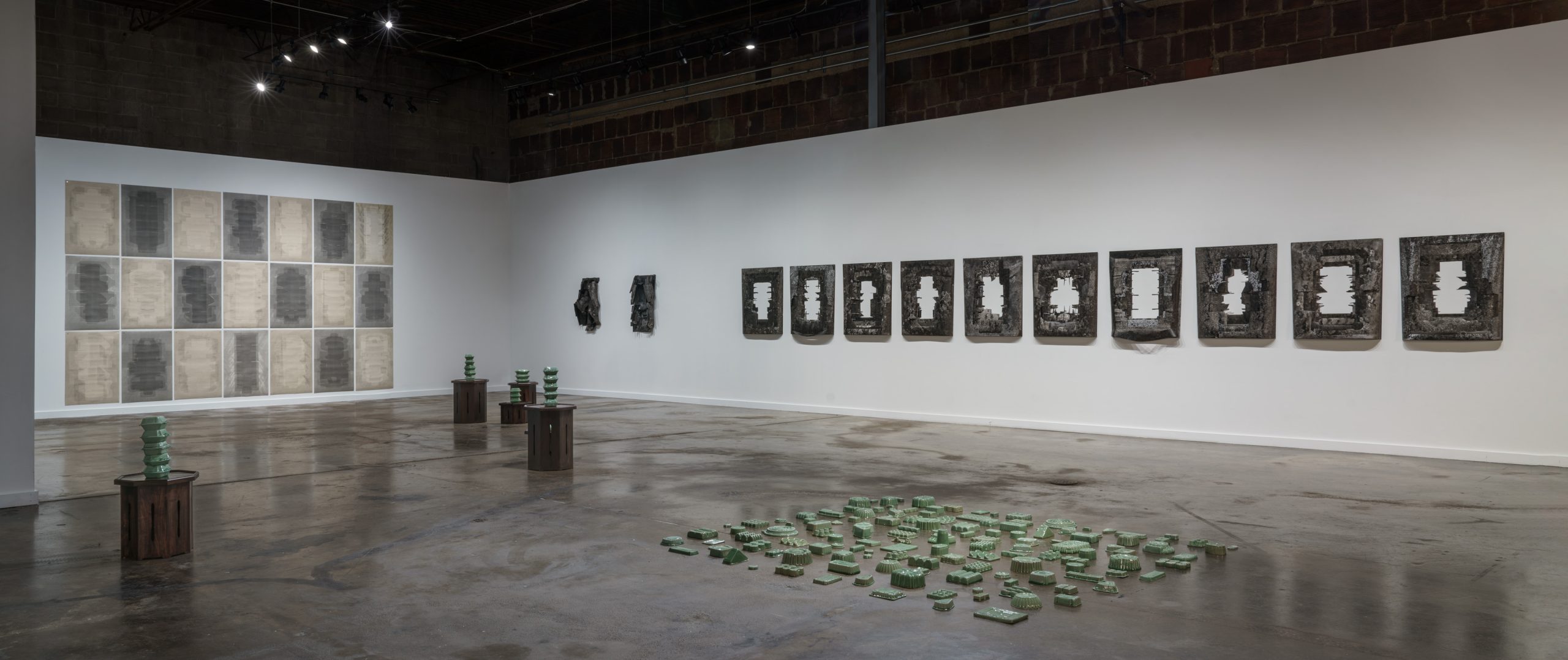Yoonmi Nam’s exhibition, Generally Meant to Be Discarded, currently on view at Studios Inc. in Kansas City, MO, provides an evolution theory retrospective on consumer culture, voyeurism, and contemporary art making. Nam’s collection of disposable take out containers originally formed as a creative response to exclusively sustaining herself on take-out during the Covid-19 Pandemic while she moved her studio to Studios Inc. In reflecting on the boxes that had begun taking up much of her living space, Nam has carefully designed fragmented sites of consumption in this exhibition. By transcending printmaking and ceramic methods, the suggested states of matter in her work categorize these objects as fossilized relics and ephemera. Nam’s medium-responsive approach to recycling investigates social-cultural traditions and archiving consumer culture under extreme circumstances.
Upon first encounter in the space, the sight lines focus the viewer in the pathway constructed on the ground through the negative space between pieces, starting with modified pedestals. These pedestals are traditionally known as soban, Korean dining tables. Placed on these pedestals are porcelain slip casts of stacked take out containers from Yoonmi’s collection. Although often built close to the floor for the purpose of eating, the varied height of these soban suggests the struggle to control ritualistic points of consumption, with containers placed on taller soban which might usually be used for activities other than eating. In the context of this display, one witnesses not only a shift from utility to sculptural showpiece, but the artist’s representation of the lasting impact of social distancing. In casting the exteriors of these stacked boxes, their green monochromatic, traditional Korean celadon glaze, personifies their evolution in the parasocial solitude of Yoomni’s home. By transitioning these containers from disposable styrofoam to more permanent porcelain physically spreading to take over space not usually used for eating, the artist reflects the collective fears caused by staying home in the beginning of the pandemic; not knowing how long we’d be in quarantine. However, the choice of celadon porcelain also symbolizes the value of self-engagement reflected in these artifacts originally produced by Americana consumer capitalism, marrying Korean traditions in her American home.
In between the two soban displays on each end of the gallery is an archaeological viewing of the variety of the ceramics placed surgically and directly on the floor. The sense of voyeurism in the exhibition increases in the Keeping series as these items were cast from the interiors of the containers, solidifying the negative space created within them, post-consumption. Unlike the soban on the perimeter, this view displays the work as fossilized relics of the discarded. This perspective also suggests the idea that these objects allude to a past of greater utility, being examined with the illusion of restoration after surviving sustained abnormal environmental conditions.
The series Delivered and Discarded displays a call and response of negative and positive cuts in Sumi Ink and alcohol-treated Tyvek®. In many ways, this transmutation of these materials visualizes gestures of refusal, refusing contamination. This speaks to the dangers of human contact in the deliveries of the containers used for this abstracted neo-calligraphy. As orders were delivered in the height of the pandemic, sanitizing the exteriors of items was thought to be imperative to keep from contracting the virus. These pieces display inverted states of matter. The Tyvek® material serves as a satirical archive, documenting the treatment of waste on material that is itself disposable. The pieces are produced by tracing collections of flattened takeout boxes on layers of Tyvek®. Where it is cut, the Tyvek® attempts to fold its way back to its original form of a roll, vaguely gesturing either a resistance to treatment or an interaction with the observer. The layered Tyvek® tracing has been dyed by the Sumi Ink, and treated with alcohol based sanitizer while still wet. The resultant chemical reaction resembles a microscopic view of a virus. The Tyvek® itself also provides an allusive resemblance to heat treated metal, symbolizing an ecological transcendence of the ink’s once gas-like state (Sumi Ink is produced of soot from burning pine trees), mirroring the transformation of disposable containers into permanent ceramics elsewhere in the exhibit. Altering these tracings communicates a continuum of recycling by mimicking the dynamics of intangible states. Contemplating the missing subjects of the negative cut outs evokes a double consciousness of human intervention in mass production. Disrupting the intended cycle of life for these containers is visually depicted as being ecologically disruptive by these time-based responses to the COVID-19 Pandemic.
The pressure print monoprint series, Unfolding, finalizes the last point of consumption before looking back on the entirety of the gallery. The alternating color of the prints combined with the ghost-like imprinting from the pressurized process create a visual binary code, applying a futurist lens to items generally meant to be discarded. This layering and movement of prints within this configuration resemble x-ray scanning as an attempt to collect more information about the conditions of the containers when scanned via their imprint. Ambiguously, they capture the passing presence of these items and reflect the need to collect as much information as possible before they decompose. Yoonmi’s special pairing of the unfolding series concludes the exhibition with the last installment of the soban, communicating that our relationship to consumption can only be repurposed by yielding the value of social engagement in the archival matrix.
“Generally Meant to be Discarded“ is on view at Studios, Inc. in Kansas City, MO from January 12 to February 24, 2024 .

About the Author: Yashi Davalos (Yashira Lopez Davalos) b.1995, is an emerging artist, writer, and independent curator. Her upbringing as an Afro Latine, Atlanta native mobilizes her objective as a curator to build artistic dialogue critiquing hyper-capitalist focus on cultural tokenism vs. non-monolithic aspects of identity. As an experimental lens-based artist, she explores the social intersections of fantasy and reality through editorial realism and archival manipulation. Yashi is a member of the 501c3 artist run collective gallery, The Front Gallery New Orleans. Yashi is currently the curatorial fellow at The Charlotte Street Foundation in Kansas City where she currently lives and works. Her past curations include Echolocation: Industrialized Persona, Past Present and Afro-Futurism at The Front Gallery and Miss/They Camaraderie 2024 at The Charlotte Street Gallery. Yashi is the Program Lead for the Timbre Arts Writing Incubator at Charlotte Street, Editor of Timbre KC Arts Reader, and current KC regional editor for MDW’s Atlas Publication. Her art has also been exhibited throughout New Orleans, at Plug Gallery in KCMO, Mint Gallery ATL, and In Partnership with Elevate ATL for Atlanta Art Week.



